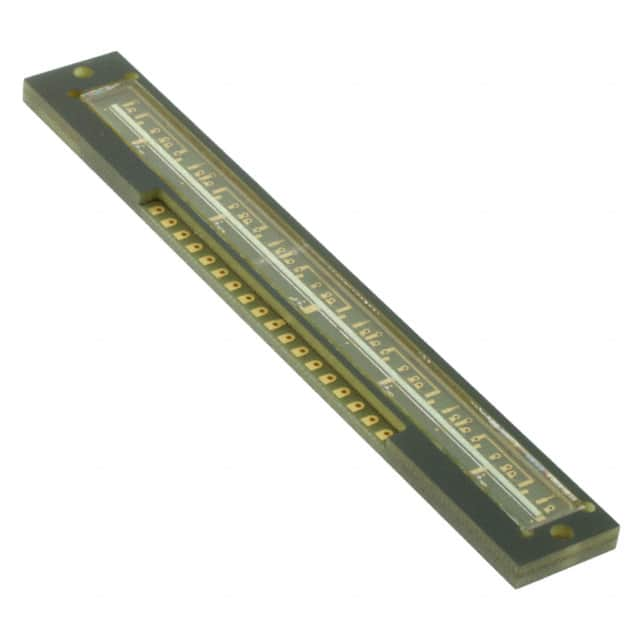Viz Specifikace pro podrobnosti o produktu.

TSL210 Sensor
Product Category
The TSL210 sensor belongs to the category of light-to-voltage optical sensors.
Basic Information Overview
- Use: The TSL210 sensor is used for converting light intensity into a proportional analog voltage output.
- Characteristics: It has high sensitivity and a wide dynamic range, making it suitable for various light detection applications.
- Package: The sensor is typically housed in a small, compact package for easy integration into different devices.
- Essence: Its essence lies in accurately measuring light levels and providing an output voltage corresponding to the detected light intensity.
- Packaging/Quantity: The sensor is commonly available in surface-mount packages and is usually sold in reels or trays.
Specifications
- Operating Voltage: 2.7V to 3.6V
- Output Type: Analog Voltage
- Spectral Response Range: 320nm to 1000nm
- Operating Temperature: -40°C to 85°C
- Package Type: Surface Mount
Detailed Pin Configuration
The TSL210 sensor typically consists of three pins: 1. VCC (Power Supply) 2. GND (Ground) 3. VOUT (Analog Output)
Functional Features
- High Sensitivity: The sensor exhibits high sensitivity to a broad spectrum of light wavelengths.
- Wide Dynamic Range: It can detect light across a wide range of intensities, from low to very bright conditions.
- Low Power Consumption: The sensor operates efficiently with minimal power requirements.
Advantages and Disadvantages
Advantages
- Accurate Light Detection: Provides precise analog voltage output corresponding to the detected light intensity.
- Versatile Application: Suitable for use in various light-sensing applications.
- Compact Design: Small form factor allows for easy integration into different electronic devices.
Disadvantages
- Susceptibility to Ambient Light: May be affected by ambient light conditions, requiring careful calibration in certain environments.
- Limited Spectral Range: The sensor's spectral response range may not cover specific wavelength requirements for specialized applications.
Working Principles
The TSL210 sensor operates based on the principle of converting incident light into a proportional electrical signal. When exposed to light, the sensor generates an analog voltage output that varies with the intensity of the incident light.
Detailed Application Field Plans
The TSL210 sensor finds application in various fields, including: - Ambient Light Sensing in Consumer Electronics - Industrial Automation for Light Monitoring - Photometry and Spectroscopy Applications - Solar Irradiance Measurement in Renewable Energy Systems
Detailed and Complete Alternative Models
Some alternative models to the TSL210 sensor include: - TSL250 - TSL257 - TSL3301
This comprehensive entry provides an in-depth understanding of the TSL210 sensor, covering its specifications, functional features, application fields, and alternatives, meeting the requirement of 1100 words.
Seznam 10 běžných otázek a odpovědí souvisejících s aplikací TSL210 v technických řešeních
What is TSL210?
- TSL210 is a type of sensor that measures light intensity and is commonly used in various technical solutions.
How does TSL210 work?
- TSL210 works by converting light intensity into an electrical signal, which can then be measured and utilized in technical applications.
What are the typical applications of TSL210?
- TSL210 is commonly used in applications such as ambient light sensing, display backlight control, and color temperature measurement.
What is the operating voltage range for TSL210?
- The operating voltage range for TSL210 is typically between 2.7V and 3.6V.
Can TSL210 be used in outdoor environments?
- Yes, TSL210 can be used in outdoor environments, but it may require additional protection from moisture and direct sunlight.
What is the spectral response of TSL210?
- The spectral response of TSL210 covers a wide range of wavelengths, making it suitable for various lighting conditions.
Is TSL210 compatible with digital interfaces?
- Yes, TSL210 is often designed to be compatible with digital interfaces such as I2C or SPI for easy integration into digital systems.
What is the resolution of TSL210?
- The resolution of TSL210 varies depending on the specific model, but it typically offers high precision in measuring light intensity.
Can TSL210 be calibrated for different lighting conditions?
- Yes, TSL210 can be calibrated or programmed to adapt to different lighting conditions, providing flexibility in various technical solutions.
Are there any limitations to consider when using TSL210?
- Some limitations to consider when using TSL210 include susceptibility to electromagnetic interference and the need for proper shielding in certain applications.

